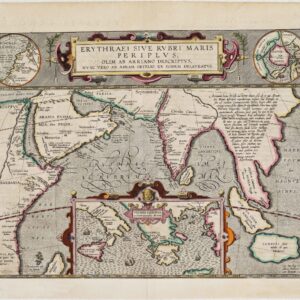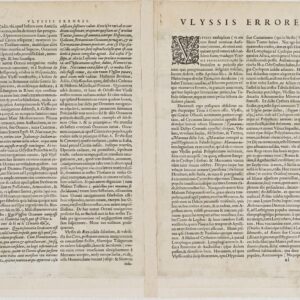Two rare official documents showcasing General Santa Anna’s pivotal role in the Texas Revolution and Mexican-American War.
Diario del Gobierno de la Republica Mexicana. Tome VII, Num. 697 [&] El Exmo. Sr. vice-presidente interino de los Estados-Unidos Mexicanos… Valentin Gómez Farías… sabed: …Sr. Presidente intorno D. Antonio Lopez de Santa-Anna, para mandar en persona y como general en gefe las fuerzas del ejécito…
$2,200
In stock
Description
In unison, these documents encapsulate two parts of Santa Anna’s spectacular career, particularly his fall from grace during the Texas Revolution (1836) and his restoration as head of the army in the Mexican-American War (1846-48). In addition to framing the most eventful decade in Santa Anna’s turbulent life, the period represented by these two documents also constitutes a decade of poor decision-making on Mexico’s side. As such, it represents a historical process that not only led to Mexico’s defeat in their war with the U.S. but, more importantly, to the Treaty of Guadalupe Hidalgo, and thus the secession of all “Upper Mexico” to the United States.
Both issued by the Mexican government, the documents form chronological bookends at either end of this prolonged loss of both territory and military and political clout.
Santa Anna’s report on the events leading up to his defeat
The first document consists of nearly the entire issue of Diario del Gobierno de la Republica Mexicana 697, in which General Santa Anna reports on troop movements and events following the Mexican victory at the Alamo in early 1836. This inevitably tragic stand of the Texas rebels saw the death of several American heroes, such as James Bowie, William B. Travis, and Davy Crockett. After the defeat, the Mexican general and president moved his army deeper into Texas, aiming to engage the full Texan Army under the command of General Samuel Houston. The events culminated in the Battle of San Jacinto, fought on April 21, 1836, near present-day La Porte and Deer Park, the final and most decisive battle of the Texas Revolution, seeing Santa Anna’s army ultimately defeated.
After this humiliation, Santa Anna was captured by the Texans and coerced to lobby the Mexican government for their cause. Once Houston was voted the new republic’s first president, Santa Anna was returned to Mexico via Washington D.C., but by then, he had been deposed from power. The reason was not only his defeat and subsequent service to the enemy but especially the brutal execution of prisoners following the Battle of Goliad. In May 1837, Santa Anna demanded a formal inquiry into the events to clear his name. The attempt at vindication was unsuccessful, but it set the stage for the creation of our report.
Following his release from US custody, Santa Anna was transported aboard the U.S.S. Pioneer to Veracruz, where he retired to his hacienda, Manga de Clavo. While recovering from his imprisonment and the concerted effort to humiliate him by the Mexican press, Santa Anna wrote a manifesto in which he reflected on his experiences and decision-making during the campaign in Texas. It was a distilled version of this manifesto published in the Diario del Gobierno de la Republica Mexicana.
Our report, written at Manga de Clavo, is dated March 11th, 1837, almost a year after the Mexican victory at the Alamo (March 6th). It was sent from Veracruz to the capital with Coronel Juan Nepomuceno Almonte. The report was Santa Anna’s attempt to reposition himself politically. Still, while it certainly garnered interest from all sides of Mexican society, it was not enough to vindicate the general in the eyes of his peers. It is clear, however, that interest in the case had not dwindled, for virtually the entire issue of this government newsletter appears to have been dedicated to Santa Anna’s report. The text relays how, after leaving San Antonio in Bexar, the army was led in the direction of San Felipe (Austin), where it would clash with Houston’s troops in the decisive Battle of Jacinto.
A return to power: Santa Anna is reinstated as head of the Mexican Army
The second document in this double-lot is an official government decree authored by Jose Maria Ortiz Monasterio, Mexico’s Minister of Foreign Affairs and Interior relations (Ministerio de relaciones interiores y esteriores). In it, the Mexican government formally reinstated Antonio López de Santa Anna as the head of the Mexican Army. The proposition was put forward on February 12th, 1847, and passed by the national legislature three days later. The decision was immediately sanctioned by Valentín Gómez Farías, Santa Anna’s old vice president (1833–34). As we shall see, the dates are part of what makes this document so historically significant.
Following their initial victory over Santa Anna, Sam Houston and other Texan leaders soon realized their fledgling republic’s hardships. The struggle for independence generated enormous debts, which now were coming due, and the threat of a new Mexican invasion loomed constantly. Houston and others understood that their chances against the full Mexican army were slim despite their initial military success. In a bid to secure permanent independence from Mexico, Texas formally requested annexation by the United States in late 1836, a request initially denied by the Secretary of State. But in 1843, President John Tyler singlehandedly decided to pursue the annexation after all, in part to bolster his chances in the upcoming election. In the final days of 1845, Texas was formally admitted to The Union as the 28th state.
In addition to significantly expanding U.S. territory, the move virtually guaranteed armed conflict with Mexico, who still had not acknowledged Texas’ independence and continued to lay claim on especially the western half of the enormous territory. With the annexation, the Mexican government was forced to choose between giving up on going to war and foolishly opting for the last choice. Santa Anna recovered his reputation during the late 1830s due to his pivotal role in Mexico’s Pastry Wars with the French. However, after a failed attempt to raise taxes in 1842 and several Mexican provinces declaring autonomy from the central government, Santa Anna was deposed again and forced into exile in Cuba. Much like the real Napoleon, his exile was short-lived, lasting only a year.
Not long after war with the United States broke out in 1846, Mexican President Mariano Paredes was removed. The government asked Santa Anna to re-assume the presidency during this crisis. Returning to his home country, Santa Anna brazenly responded that he had no presidential aspirations but was willing to use his military experience in the current conflict with the U.S. While President Polk secretly had negotiated a favorable deal with Santa Anna while he was still in Cuba, the Americans now found the Mexican generalissimo obstinate and rejecting. Consequently, American military resources were redirected to prepare for a full invasion of Mexico. Our second document should be seen and understood in this specific light. Once it had passed the legislature, Santa Anna had to scramble the Mexican army to meet the approaching US forces commanded by General Winfield Scott. The two armies clashed at the Battle of Buena Vista on the 22nd of February, underscoring how little time there was for the Mexican government to get the legalities of Santa Anna’s command in order.
While Santa Anna’s full story extends far beyond the Mexican-American War, it was his conviction to engage the United States head-on in this conflict that not only would define his legacy but, indeed, shape the national boundaries of both countries irrevocably. These documents capture the significance of that moment in our continent’s history.
Census
Both of the documents are official publications of the Mexican government. While one was published in a government bulletin, the other was printed for the formal announcement of the decree.
Document 1: “Parte Official. Gobierno General. Secretaria de Guerra y Marina”, published in Diario del Gobierno de la Republica Mexicana (Tome VII, Num. 697). While other volumes of this government series figure in various institutional collections, the OCLC does not include any listings of this particular issue. While we expect that an example of this government publication must exist in the Biblioteca Nacional de México, searches in the Nautilo catalog (https://catalogo.iib.unam.mx/) have yielded no results.
Document 2: El Exmo. Sr. vice-presidente interino de los Estados-Unidos Mexicanos, se ha servido dirigirme el decreto que sigue : “Valentin Gómez Farías, vice-presidente interino de los Estados-Unidos Mexicanos, y en ejercicio del supremo poder ejecutivo, á los habitantes de la República, sabed: que el soberano congreso constituyente ha derectado lo que sigue… intorno D. Antonio Lopez de Santa-Anna, para mandar en persona y como general en gefe las fuerzas del ejécito[…]. The OCLC lists one institutional holding of this decree (no. 54155290) at Yale University.
Cartographer(s):
Condition Description
Post-Alamo Santa Anna report: Archival tape repair along spine fold; very good. 28.5 x 39.25 cm (11.25 x 15.5 in)
Santa Anna given command of Mexican Army 1847: A few faint folds and creases, fine or nearly so. One page, on first page of 4-page conjugate, the other pages blank. 15.5 x 22 cm (6.25 x 8.75 in)
References
![[Vietnamese Maps of North America: Mexico, Canada, USA]](https://neatlinemaps.com/wp-content/uploads/2022/04/NL-01262-USA_thumbnail-scaled-300x300.jpg)
![[Title in Russian] Russian Empire in the 18th Century (European Section)](https://neatlinemaps.com/wp-content/uploads/2020/04/NL-00822_Thumbnail-300x300.jpg)
![[Title in Russian] Russian Empire in the 18th Century (European Section)](https://neatlinemaps.com/wp-content/uploads/2020/04/NL-00822-scaled-300x300.jpg)


